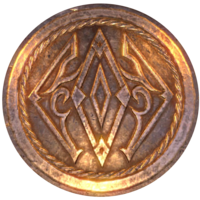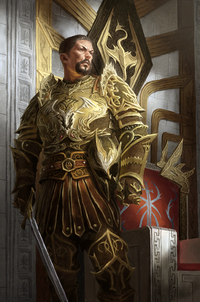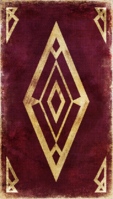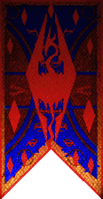Lore:Empire
This article is about Cyrodilic Empire of Men. For other empires on Nirn, see Empires.
The Empire is a contemporary term referring to the realms under the rule of Men on the continent of Tamriel. There have been three such Empires in recorded history, and the rule of any given Empire spans centuries. While all these Empires reigned over great swaths of Tamriel, Tiber Septim's Third Empire is the only empire which united all of Tamriel under one banner.
The Empire should not be confused with other empires, such as the First Empire of the Nords or the Kingdom of Alinor.
Contents
Alessian Empire[edit]
The Alessian Empire, also called the First Empire,[1] the Empire of Cyrodiil,[2][3] and the Empire of Men,[4] was established by the former Nede slaves of the Ayleid Empire in 1E 243 following the Alessian Slave Rebellion.[5] The Empire traces its founding to the moment when Saint Alessia received the Dragonfires and the Amulet of Kings from Akatosh; she used the Amulet to drive the Daedra out of the mortal realm.[6] Their empire would last for over two thousand years. Akatosh told Alessia that as long as the Dragonfires remained lit and her heirs wore the Amulet of Kings, the gates of Oblivion would remain shut and Tamriel would be spared the depredations of the Daedra.[6]
Only a few rulers of the First Empire are now known: Queen Alessia, its founder and spiritual leader; Belharza the Man-Bull, Alessia's heir by her consort Morihaus, crowned in 1E 266; Gorieus, crowned in 1E 461; and Hestra, who expanded the reaches of the Empire all the way to High Rock in 1E 1029.[7] One of the defining events of the Empire was the rise of the zealously monotheistic Alessian Order, which followed the teachings of the prophet Marukh.[8] The Order's influence spread rapidly until, in 1E 361, its puritanical doctrines were formally adopted and enforced by the Empire.[9] Thereafter, the arch-prelates of the Order were said to wield almost as much power as the emperors themselves.[10] It was a sect of the Order called the Marukhati Selective that was responsible for the Dragon Break known as the "Middle Dawn".[11][12]
The Alessian Empire's territory fluctuated considerably throughout its history. At its inception it encompassed East Cyrodiil, including the Nibenay Valley and the White-Gold Tower, which later became the centerpiece of the Imperial City; West Cyrodiil remained a patchwork of independent Colovian kingdoms that resisted the Alessian Order's dogma.[8][13] A number of Ayleid vassal-states also briefly existed under the Empire's umbrella until the xenophobic Alessian Order methodically extinguished them.[9] The allied city-state of Miscarcand initially resisted the Alessian Order by force, but over time its inhabitants fled to Valenwood to avoid persecution.[14] Following the defeat and death of High King Kjoric the White in 1E 478, the Empire seized portions of southern Skyrim, but failed in its bid to acquire the Kingdom of Skingrad.[13] A westward expansion and attempt to annex High Rock was likewise thwarted at the Battle of Glenumbra Moors in 1E 482, which would be remembered as one of the Order's most disastrous mistakes.[15][16] High Rock would later be inducted into the Empire in 1E 1029 after the Empress Hestra defeated King Styriche, the Vampire of Verkarth, only to reassert its independence in 1E 2305 in response to the Alessian Order's excesses.[1] In 1E 1033 the Alessians under Hestra invaded Black Marsh to suppress the pirates led by Red Bramman operating from the Topal Bay.[17] An unknown Alessian Emperor agreed to fund the All Flags Navy's campaign against the Sload of Thras in 1E 2241.[18] Under the command of King Bendu Olo, the fleet sailed to Thras in 1E 2260 to mete vengeance upon the Sload for releasing the Thrassian Plague on the people of Tamriel.[19]
The final days of the Empire arrived in 1E 2321, when tensions within the Alessian Order's bloated priesthood gave way to internal strife, prompting the kingdoms of West Cyrodiil to completely sever ties with the Empire and establish their own government, the Colovian Estates.[8] Hemorrhaging money and land, the Empire finally broke under the strain and the War of Righteousness erupted.[8] After a decade of violence that wiped out half of the population of the Iliac Bay[20][21] and saw the loss of the Order's extensive monastic complex at Lake Canulus,[22] among untold other atrocities, the war ended in 1E 2331 with the dissolution of the Alessian Order[8] and the enthronement of a puppet emperor by the king of Skingrad.[23] Cyrodiil and Tamriel would remain divided until the rise of Reman I and the foundation of the Second Empire in 1E 2703.[8]
Second Empire[edit]
The Second Empire, also known as the Cyrodilic Empire,[8] the Reman Empire,[24] Reman's Imperium,[25] the Empire of Cyrodiil,[26] and the Second Empire of Men,[8] was a human-led empire that, at its height, controlled every region of Tamriel with the exception of Morrowind.[8] The history of the Second Empire is divided into two main periods: the reign of the Reman Dynasty that witnessed the final centuries of the First Era, and the subsequent Akaviri Potentate that ushered in the Second Era.
Interregnum[edit]
Empire of Cyrodiil[edit]
The Empire of Cyrodiil[27][28] (also known as the Imperial Empire)[29] refers to an Imperial state that existed during the early years of the Interregnum. Although identified as an empire, it differed from the Alessian Empire, Second Empire, and Third Empire in that its only permanent dependency was Cyrodiil itself, and it was at no time ruled by a Dragonborn emperor.
Third Empire[edit]
The Third Empire (also called the Septim Empire,[30] Tamrielic Empire,[31][32] Holy Cyrodiilic Empire of Tamriel,[33] and the Glorious Empire)[34] was declared by Tiber Septim in 2E 854 after the chaos of the Interregnum, and was forged through a decades-long conflict to unite Tamriel known as the Tiber War.[8] It lasted throughout the whole of the Third Era and two centuries into the Fourth Era, when it began to decline.
Septim Dynasty[edit]
The Septim Dynasty was founded by Tiber Septim upon using Numidium to conquer the whole of Tamriel, after which he declared the start of a new era, 3E 0.[35] His rule of 38 years was prosperous and relatively peaceful. His grandson Pelagius succeeded him, and was poised to continue the golden age, until he was assassinated by the Dark Brotherhood after reigning for less than three years.[35] Pelagius had no living children, thus the Ruby Throne passed to Tiber's niece, Kintyra, in 3E 41. Kintyra and her son, Uriel, were successful rulers who achieved a level of unity within the Empire that would not be equaled for centuries.[36] Uriel II, who took the throne in 3E 64, had his 18-year reign blighted by plagues and insurrections, and accomplished little during his rule. Instead, he left many problems, and a great deal of debt, to Pelagius II. In response, Pelagius dismissed the entire Elder Council and allowed only those who paid a princely sum to return to their seats. While this tactic brought some prosperity back to Tamriel, it ended when Pelagius was poisoned in 3E 98, purportedly by a disgruntled former Council member.[37] His son, Antiochus, was more interested in debauchery than politics, known across the Empire as a womanizer even before taking the throne. His reign was marred by civil war and other conflicts, and the province of Summerset was almost lost to invading Maormer in 3E 110. Antiochus died in 3E 120, leaving the throne to his daughter, Kintyra II. The succession was contested by Antiochus' nephew and sister and would lead to civil war.[38]
In 3E 121, Kintyra II was imprisoned by Potema, the infamous Wolf Queen of Solitude, and murdered two years later. This triggered the War of the Red Diamond, a civil war between Potema and her son Uriel III on one side, and Potema's brothers Cephorus and Magnus on the other. Cephorus defeated Uriel III at the Battle of Ichidag, and Uriel III was captured but killed by a mob while en route to the Imperial City to stand trial, so Cephorus was proclaimed emperor.[37][30]
The Empire gained and lost power and land unpredictably during the next century until the rise of Katariah Ra'Athim. The first (and only) Elven ruler of the Empire, Katariah was the first in 100 years to secure a steady, iron grip over most of Tamriel, save Black Marsh. Ultimately, this would be the Empress' undoing, as she died in 3E 200 in a minor skirmish in Black Marsh.[39]
Another civil war broke out after the Elder Council voted to disinherit Andorak, the son of Uriel IV, and offer the Imperial crown to his cousin Cephorus instead, as they considered Cephorus to be more closely related to the true Septim bloodline. The war lasted nine years until Andorak was mollified by the offer of the throne of Shornhelm in High Rock.
After acceding to the throne in 3E 268, Uriel V led the conquests of Roscrea, Cathnoquey, Yneslea, and Esroniet, as well as the Tamrielic Invasion of Akavir, but he was killed during the invasion of Akavir.[40][41] Uriel V's son Uriel VI was crowned after his father's death but was unable to take the throne until 3E 307, due to his young age at the time of his father's death and his mother Thonica's attempts to stay in power as regent. When Uriel VI fell from his horse and died in 3E 313, his half-sister came to power as Empress Morihatha. Morihatha slowly brought her rebellious vassals back under imperial control, and by the end of her reign in 3E 339, Tamriel was nearing a sort of unity. Her nephew, Pelagius IV, continued his aunt's work, bringing the Empire closer to unity than it had been since the days of Uriel I.[36]
Uriel VII, son of Pelagius IV, came to power after his father's death in 3E 368. In 3E 389, Uriel VII's battlemage, Jagar Tharn, managed to imprison the Emperor in a dimension of Tharn's own creation. For ten years, a period later known as the Imperial Simulacrum, Tharn ruled in Uriel's place, but showing none of the latter's wisdom. Before Tharn could entirely drive the Empire into the ground, Uriel was rescued and restored to the throne in 3E 399.[30]
Contemporarily to this period, some institutions of the Empire were suspended in so-called Pocket Universe, to achieve a state of immaculate virtual reality. One such institution was Battlespire, the proving ground and sophisticated war college of prospective Imperial Battlemages; located deep in the ethereal plane.[42]
The Empire recovered from Tharn's deceit, and Uriel VII united the Empire for the first time in centuries. By the end of the Imperial Simulacrum, Warp in the West, and the Vvardenfell Crisis, the Empire was even closer to unity than at the end of Pelagius IV's reign. After his assassination in 3E 433, Uriel VII's illegitimate son, Martin Septim, ended the Oblivion Crisis, the Third Era, and the Septim Dynasty.
High Chancellor Ocato became Potentate Ocato when no candidate to replace Martin could be found. Ocato kept the Empire more or less intact in the tumultuous years after the Oblivion Crisis, but was assassinated circa 4E 15, which ushered in the seven-year Stormcrown Interregnum.[43]
Mede Dynasty[edit]
At some point in the seven years following Ocato's assassination, a Nibenese witch-warrior named Thules the Gibbering was crowned Emperor, although he was not well liked by the people, the Elder Council favored him over Titus Mede, a Colovian warlord who sought the throne. Eventually, in 4E 22, Titus Mede captured the Imperial City from Thules and crowned himself the first emperor of the Mede Dynasty, eventually persuading the Elder Council to accept him as a liberator rather than a conqueror.[43][44]
During his rule, the province of Hammerfell was reclaimed, alongside the city-states of Leyawiin and Bravil.[43][45]
In 4E 168, Emperor Titus Mede II acceded to the throne. The Empire was at that time a shadow of its former glory. Valenwood and Elsweyr had been lost to the Aldmeri Dominion[43], and Black Marsh had been lost to Imperial rule since the Oblivion Crisis. Morrowind had yet to fully recover from the eruption of Red Mountain, and had ceased to be an Imperial territory at some point prior to 4E 48.[46][45][44] Hammerfell was plagued by infighting between the Crowns and Forebears. Only High Rock, Cyrodiil, and Skyrim remained prosperous and peaceful.[47]
In 4E 171, the Great War began when armies from the Aldmeri Dominion invaded the Imperial provinces of Hammerfell and Cyrodiil after Titus II rejected an ultimatum to make massive concessions to the Thalmor. An army led by Thalmor general Lord Naarifin emerged from hidden camps in northern Elsweyr and assaulted southern Cyrodiil, flanking Imperial defenses along the Valenwood border. Leyawiin fell to the invaders, and Bravil was surrounded and besieged. Simultaneously, an army under Lady Arannelya crossed western Cyrodiil, bypassing Anvil and Kvatch and entering Hammerfell. This army was joined by smaller forces landing on Hammerfell's coast. Imperial troops were forced into retreat across the Alik'r Desert. The Imperial City was besieged, and fell after the Emperor fled with the remnants of his army to Skyrim. The war ended a year later with the liberation of the Imperial City after the Battle Of The Red Ring, and with the subsequent Imperial acceptance of the White-Gold Concordat. This treaty contained terms almost identical to those rejected before the war, specifically the outlaw of Talos worship, which became one of the main causes of the Stormcloak Rebellion in Skyrim. The Empire was forced to cede Hammerfell after the Redguards refused to give up large sections of their land, and the Redguards continued the war against the Dominion alone until the two sides signed the Second Treaty of Stros M'Kai in 4E 180. This left the Empire in a diminished and less stable condition, though it retained control of the provinces of Cyrodiil, High Rock, and Skyrim.[47]
In 4E 201, the Stormcloak Rebellion broke out in Skyrim. The belligerents were the Stormcloaks, led by Ulfric Stormcloak, who fought for the independence of Skyrim, and the Empire's Imperial Legion forces, led by General Tullius, with the intention of holding the Empire together in the face of growing political tensions between them and the Thalmor.[48]
Gallery[edit]
References[edit]
- ^ a b Bangkorai, Shield of High Rock — King Eamond
- ^ A Life of Strife and Struggle — King Laloriaran Dynar
- ^ The Onus of the Oghma — Phrastus of Elinhir
- ^ The Bretons: Mongrels or Paragons? — Phrastus of Elinhir
- ^ Pocket Guide to the Empire, 3rd Edition: All the Eras of Man, A Comprehensive History of our History — Imperial Geographical Society, 3E 432
- ^ a b Trials of St. Alessia
- ^ Loading screen in ESO
- ^ a b c d e f g h i j Pocket Guide to the Empire, 1st Edition: Cyrodiil — Imperial Geographical Society, 2E 864
- ^ a b The Last King of the Ayleids — Herminia Cinna
- ^ Chancellor Abnur Tharn Answers Your Questions — Chancellor Abnur Tharn
- ^ Where Were You ... Dragon Broke — Various
- ^ Vindication for the Dragon Break — Fervidius Tharn, Arch-Prelate of the Maruhkati Selective
- ^ a b Rislav The Righteous — Sinjin
- ^ Beragon's dialogue in ESO
- ^ Pocket Guide to the Empire, 1st Edition: High Rock — Imperial Geographical Society, 2E 864
- ^ Shezarr and the Divines — Faustillus Junius
- ^ Pocket Guide to the Empire, 3rd Edition: The War with the Trees: Argonia and the Black Marsh — Imperial Geographical Society, 3E 432
- ^ 2. Baron-Admiral Bendu Olo
- ^ 4. Instrument of Vengeance
- ^ The War of Betony — Vulper Newgate, 3E 404
- ^ A History of Daggerfall — Odiva Gallwood
- ^ Cleansing of the Fane
- ^ On the War of Righteousness — Valenca Arvina, Historian-in-Residence at Gwylim University
- ^ True Heirs of the Empire — Erystera Ligen
- ^ Crafting Motif 26: Daggerfall Covenant Style — General Baryctor Stelanie
- ^ History of the Fighters Guild
- ^ True Heirs of the Empire — Erystera Ligen
- ^ Knights of the Dragon
- ^ Empress Regent Clivia Tharn's dialogue in ESO
- ^ a b c Brief History of the Empire — Stronach k'Thojj III
- ^ Geography of Morrowind dialogue option in Morrowind
- ^ Pocket Guide to the Empire, 3rd Edition: The Seat of Sundered Kings: Foreword — Imperial Geographical Society, 3E 432
- ^ The Wolf Queen, v1 — Waughin Jarth
- ^ Imperial dialogue option in Morrowind
- ^ a b Brief History of the Empire v 1 — Stronach k'Thojj III
- ^ a b Brief History of the Empire v 4 — Stronach k'Thojj III
- ^ a b Biography of the Wolf Queen — Katar Eriphanes
- ^ The Wolf Queen, v6 — Waughin Jarth
- ^ Brief History of the Empire v 2 — Stronach k'Thojj III
- ^ Report: Disaster at Ionith — Lord Pottreid, Chairman
- ^ Brief History of the Empire v 3 — Stronach k'Thojj III
- ^ Battlespire Athenaeum — Ronald Wartow
- ^ a b c d Rising Threat — Lathenil of Sunhold
- ^ a b Lord of Souls — Greg Keyes
- ^ a b The Infernal City — Greg Keyes
- ^ Adril Arano's dialogue in Skyrim: Dragonborn
- ^ a b The Great War — Legate Justianus Quintius
- ^ Events of Skyrim
Note: The following references are considered to be unofficial sources. They are included to round off this article and may not be authoritative or conclusive.
|
|||||







